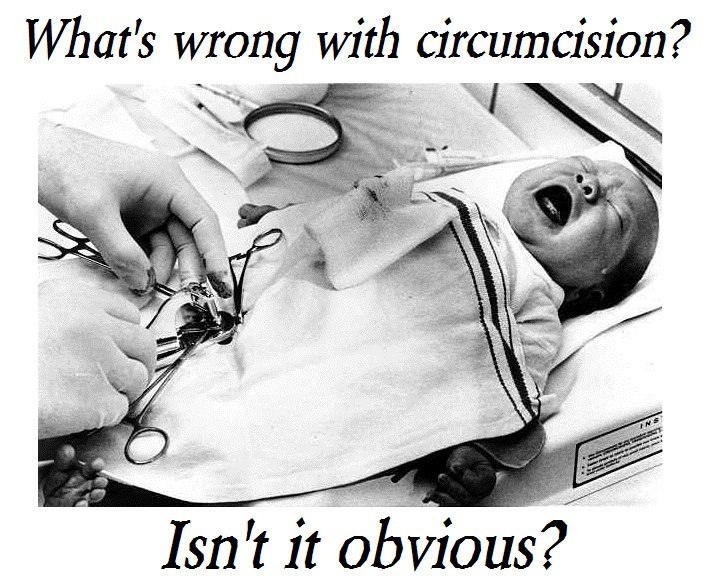America is unique among developed nations for believing evolution made a mistake creating the human penis. Most Americans believe the foreskin is an evolutionary blunder. Most of us never learn what the foreskin is or anything about it. In our ignorance we believe it is a worthless, vestigial “flap of skin,” and we treat it as if it were a serious birth defect that justifies performing surgery on infants.
What is the foreskin?
The foreskin is not merely skin. The membrane of the foreskin comprising the ridged band and frenulum extending to the inner tip of the foreskin form a ring that is the most sensitive part of the penis and very and pleasurable. This ring of sensitive tissue stretches as it moves over the glans multiplying the ways the penis feels pleasure.
The foreskin contains important blood vessels, nerves and nerve endings. The largest visible artery of the penis, the dorsal artery extends through the skin and foreskin to supply blood to the urethral chamber of the penis. This blood supply appears to be very important for allowing the meatus to develop to full size. Many doctors have hypothesized this is why infant circumcision causes meatal stenosis, narrowing of the meatus and urethra, because meatal stenosis is a very common complication of infant circumcision.
The penis is innervated by two separate branches of the pudendal nerve, the dorsal nerve and the perineal nerve. The dorsal nerve passes from two branches along the upper side of the penis to innervate most of the penis. The perineal nerve innervates the urethral chamber, frenulum and ventral foreskin. Branches of the perineal nerve extend to the ridged band through the frenulum. Both nerves innervate the ridged band of the foreskin, which explains why it is the most pleasurable part of the penis along with the frenulum.
Circumcision removes the ridged band and most or all of the frenulum. A small remnant of the frenulum is usually the only highly sensitive part that remains, and in many cases even it may not be very sensitive after it has been exposed to friction since infancy.
The foreskin is functional besides sensitive. Research has demonstrated it makes masturbation and sex better for a man and his partner. The grooved texture of the foreskin increases friction relative to the smoother texture of circumcised penis, but the way that the foreskin moves reduces friction where the skin moves. This makes sex and masturbation feel better than they do with tight, immobile skin.
Why do we perform surgery on infants?
Most people assume circumcision must be worthwhile simply because we do it. This logic is circular and illogical.
Infant circumcision is a cultural mistake first introduced in the 1850s for the express purpose of reducing the pleasure in sex and masturbation. Since then it has been reinforced by certain parties interested in maintaining the tradition. Since the 1980s, circumcision activists have insinuated themselves into positions of influence in certain influential organizations like the media and certain American medical organizations to promote circumcision with the authority of the organizations they represent. Since the 1990s, circumcision activists have been very active on the internet advancing narratives fabricated to promote infant genital cutting.
In contrast to American medical and media organizations that promote infant circumcision, medical organizations in other developed countries have issued statements questioning or condemning infant circumcision. Some of these medical organizations include the Canadian Paediatric Society, College of Physicians and Surgeons of Saskatchewan, College of Physicians and Surgeons of Manitoba, College of Physicians and Surgeons of British Columbia, Australian Pædiatric Association, Australian College of Pediatrics, Australasian Association of Paediatric Surgeons, Royal Australasian College of Physicians, Australian Medical Association, Paediatric Society of New Zealand, New Zealand Society of Paediatric Surgeons, Belgium Advisory Committee on Bioethics, British Medical Association, British Association of Paediatric Surgeons, British Association of Paediatric Urologists, General Medical Council of the United Kingdom, Royal Dutch Medical Association, Netherlands Society of General Practitioners, Netherlands Association for Paediatric Medicine, Netherlands Urology Association, Netherlands Surgeons Association, German Association of Pediatricians, German Association of Child and Youth Doctors, Nordic Association of Clinical Sexology, Finnish Association for Sexology, Norwegian Society for Clinical Sexology, Danish Association for Clinical Sexology, Swedish Association for Sexology, Icelandic Sexology Association, Estonian Academic Society for Sexology, Icelandic Medical Association, Nordic Ombudsmen for Children, Finnish Association of Pediatric Surgeons, Finnish Medical Association, Norwegian Council of Medical Ethics, Norwegian Children’s Ombudsman, Norwegian Medical Association, Norwegian Nurses Organization, Norwegian Nursing Association, Swedish Pediatric Society, Swedish Children’s Ombudsman, Swedish Society of Medicine, Swedish Society of Health Professionals, Swedish Paediatric Society, Swedish Association of Pediatric Surgeons, Danish Society of Family Physicians, Danish Medical Association, Danish Society for Anaesthesiology and Intensive-care Medicine, and South African Medical Association.
